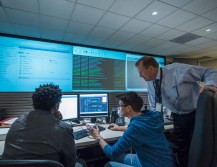The world of transportation data is about to explode as more means of travel become digitally interconnected, making the amount of data the Transportation Department handles today “look like child’s play,” Richard McKinney, the department’s chief information officer, said recently. That’s why, in preparation for that inevitable surge of data, McKinney hired DOT’s first ever chief data officer.
“One of the things that makes it really important we get our acts together around data is the digital transportation world that is about to unfold,” McKinney said in October at ACT-IAC’s Executive Leadership Conference in Williamsburg, Virginia. Pointing to information generated from vehicles connected thanks to the Internet of Things and bridges and roads with sensors talking to cars, he said, “All of that data is sort of like standing on the beach and seeing that wave that’s building. It’s way out there, but you can see it. So you can either get ready for that, or you can get swamped.”
Rather than be crushed by that tsunami of data, McKinney, who just joined DOT as CIO in May, created a position in his office to focus specifically on the department’s management of data. “We were doing a fairly good job of giving the data away,” he said. “But we really wanted, in my opinion, to do a great job internally, analyzing our own data, sharing our own data internally.”
“I’m a firm believer that IT is a team sport, and the real role of the CIO is to assemble a good team — to find people who are smarter than you are and who are more capable than you are and enable them and work on their behalf to get the things that are in their way out of their way,” McKinney said. Almost serendipitously, he noticed a contractor in IT meetings who was “a lot smarter than me and probably knew more about the department’s data than anybody in the room,” he said.
Fittingly nicknamed “Data Dan,” this man, Dan Morgan, would become the department’s first chief data officer, not to mention one of the first in the federal government. Now, three months into the job, he said one of his biggest roles as CDO is “bringing the ‘I’ back into CIO,” he said, referring to the position’s central focus on information.
“And that means we have to do some things that we’ve forgotten how to do,” like measuring data quality and building Web data services for easier data access, Morgan said at the conference. Much of that, he said, has to do with managing and governing the data at the source for easier internal consumption.
There’s also some work to be done with the states and their collection and delivery of quality data. “We rely heavily on our state partners to get us good data,” he said, so it’s important DOT makes sure it’s “actually giving states the tools to be successful.”
McKinney said the department has to begin the conversation and define data elements before its too late. “How can we now, before we build this digital world, define these data elements? In other words, let’s not get 15 years into this and allow these sort of data-definition conversations take place all over the place” and then have to build around and accommodate to them, he said. “Why don’t we have the conversation now … before we make these large investments.” That’s a role Morgan and DOT can play, McKinney posited, “as a convener of a conversation, and see if we can’t get industry and state and local and the federal government to have a robust conversation about it.”
For instance, Transportation has a data set that the president talks about each year in his State of the Union Address about how many bridges are eligible for repair. “We’ve been releasing it the same way since 1992,” Morgan said. “We could probably take another look at that see if we can do a better job.”
A large part of doing that, the chief data officer said, is being the risk aggregator, encouraging those in the department and at the state and local levels to try something new. “If I can find a way to give people a sandbox where they can get that done, and then we continue to inject that back into the architecture and say ‘This is part of what we need to do as an agency,’ that’s a lot easier than all the sub-agencies and all the offices throwing small amounts of money at the problem, or sometimes way too much money at the problem with no actual direction, and bringing it to a place where we can experiment as an agency and decide to move forward,” Morgan said.
Getting Transportation in great shape and prepared for the onslaught of data it’s soon to face is no easy job. Morgan said, “It’s not going to get fixed in year one. This is going to be a long journey,” something more like five years, he told McKinney.
“Transportation is only going to get more connected,” he said. “We’re only going to get more and more sensors. The Department of Transportation is not and infrastructure operator, but all of our state and local partners are. We need be able to provide some federal leadership on what it takes to be successful in this environment. The next conversation, and the conversation that’s going to create all of the problems, is what to exchange, how to store it and what does it mean? How do you retain that context over time?”
McKinney agreed and said he was going to give Morgan whatever he needs to succeed. Already, he’s promoted Steve Lewis, chief geospatial information officer in DOT, to partner with Morgan on data operations, adding a geospatial element to their work. Speaking of Morgan, McKinney said, “I doubled him right of the gate.”




